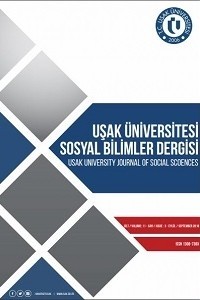SAĞLIK HARCAMALARI-İKTİSADİ BÜYÜME İLİŞKİSİ: SEÇİLMİŞ OECD ÜLKELERİ İÇİN PANEL BOOTSTRAP GRANGER NEDENSELLİK ANALİZİ
Abstract
Eğitimle birlikte sağlık imkanları, beşeri sermaye ve işgücü niteliğini şekillendirmektedir. Sağlık harcamaları, sağlık hizmetlerine erişim sayesinde büyüme performansının gelişimine katkıda bulunur. Bu çalışmada, 17 OECD ülkesi için 2000-2017 dönemi sağlık harcamaları ile iktisadi büyüme arasındaki nedensellik ilişkisi incelenmiştir. Değişkenlere ait veriler, Konya (2006) nedensellik testi kullanılarak analiz edilmiştir. Ulaşılan sonuçlarla, Danimarka, Almanya ve İsveç için iktisadi büyümeden sağlık harcamalarına; Belçika, Yunanistan, İzlanda, İtalya, Lüksemburg, Hollanda ve Portekiz için sağlık harcamalarından büyümeye doğru tek yönlü nedensellik ilişkisi tespit edilmiştir. Avusturya, İsviçre, İrlanda ve Türkiye için değişkenler arasında çift yönlü nedensellik ilişkisi gözlemlenmiştir. Panel genelinde ise, sağlık harcamaları ile iktisadi büyüme arasında çift yönlü nedensellik ilişkisi olduğu bulgusu elde edilmiştir. Sağlık harcamalarına ayrılan kaynaklar hem büyüme performansını hem de insan yaşam kalitesi ve beşeri sermayeyi geliştirerek büyüme potansiyelini desteklemekte; böylece artan milli gelir sayesinde sağlık için daha fazla kaynak ayırma imkanı sağlamaktadır.
References
- Baltagi, B. H. ve Moscone, F. (2010). Health Care Expenditure and Income in the OECD Reconsidered: Evidence from Panel Data. Economic Modelling, 27 (4), 804-811.
- Boussalem, F., Boussalem, Z., ve Taiba, A. (2014). The Relationship Between Public Spending on Health and Economic Growth in Algeria: Testing for Co-integration and Causality. International Journal of Business and Management, 2 (3), 25-39.
- Breusch, T. ve Pagan, A. (1980). The LM Test and Its Application to Model Specification in Econometrics. Review of Economic Studies, 47, 239-254.
- Çetin, M. ve Ecevit, E. (2010). Sağlık Harcamalarının Ekonomik Büyüme Üzerindeki Etkisi: OECD Ülkeleri Üzerine Bir Panel Regresyon Analizi. Doğuş Üniversitesi Dergisi, 11 (2), 166-182.
- Dreger, C. ve Reimers, H. E. (2005). Health Care Expenditures in OECD Countries: A panel Unit Root and Cointegration Analysis. IZA Discussion Paper, 1469, 1-20.
- Elmi, Z.M. ve Sadeghi, S. (2012). Health Care Expenditures and Economic Growth in Developing Countries: Panel Co-İntegration and Causality. Middle East Journal of Scientific Research, 12 (1), 88-91.
- Esteve, V. ve Martinez-Zahonero, J. L. (2007). Testing The Long-Run Relationship Between Health Expenditures and GDP in the Presence of Structural Change: The Case of Spain. Applied Economics Letters, 14 (4), 271-276.
- Gerdtham, U.G.ve Jonsson, B. (2000). International Comparisons of Health Expenditure: Theory, Data and Econometric Analysis. In Handbook of Health Economics, 1, 11-53.
- Gyimah-Brempong, K. ve Wilson, M. (2004). Health Human Capital and Economic Growth in Sub-Saharan African and OECD Countries. The Quarterly Review of Economics and Finance, 44 (2), 296-320.
- Hatam, N., Tourani, S., Homaie, R. E., ve Bastani, P. (2016). Estimating the Relationship Between Economic Growth and Health Expenditures in ECO Countries Using Panel Cointegration Approach. Acta Medica Iranica 54 (2), 102-106.
- Heshmati, A. (2001). On the Causality Between GDP and Health Care Expenditure in Augmented Solow Growth Model. SSE/EFI Working Paper Series in Economics and Finance, 423, 1-19.
- Hussain, M., Mushtaq, K., ve Saboor, A. (2009). To Investigate The Long–Run Equilibrium Relationship Between Health Expenditure and Gross Domestic Product: A Case Study of Pakistan. Pakistan Journal of Life and Social Sciences, 7 (2), 119-122.
- Kesbiç, C. Y. ve Salman, G. (2018). Türkiye’de Sağlık Harcamaları ve Ekonomik Büyüme Arasındaki İlişkinin Tespiti: 1980-2014 VAR Model Analizi. Finans Politik ve Ekonomik Yorumlar, 639, 163-180.
- Konya, L. (2006). Exports and Growth: Granger Causality Analysis on OECD Countries with a Panel Data Approach. Economic Modeling, 23 (6), 978-992.
- Ogungbenle, S., Olawumi, O. R. ve Obasuyi, F. O. T. (2013). Life Expectancy, Public Health Spending and Economic Growth in Nigeria: A Vector Autoregressive (VAR) model. European Scientific Journal, 9 (19), 210-235
- Öztürk, S. ve Topçu, E. (2014). Health Expenditures and Economic Growth: Evidence from G8 Countries. International Journal of Economics And Empirical Research, 2 (7), 262- 267.
- Pesaran, M.H., Ullah, A. ve Yamagata, T. (2008).A Bias-Adjusted LM Test of Error Crosssection Independence. The Econometrics Journal, 11 (1), 105-127.
- Piabuo, S.M. ve Tieguhong, J. C. (2017). Health Expenditure and Economic Growth: A Review of The Literature and An Analysis Between the Economic Community for Central African States (CEMAC) and Selected African Countries. Health. Economics Review, 7 (23), 1-13.
- Rizvi, S.A.F. (2019). Health Expenditures, Institutional Quality and Economic Growth. Empirical Economic Review, 2 (1), 63-82.
- Saraçoğlu S. ve Songur, M. (2017). Sağlık Harcamaları ve Ekonomik Büyüme İlişkisi: Avrasya Ülkeleri Örneği. Kafkas Üniversitesi İktisadi ve İdari Bilimler Fakültesi Dergisi, 8 (16), 353-372.
- Sghari, M. B. A. ve Hammami, S. (2013). Relationship Between Health Expenditure and GDP in Developed Countries. IOSR Journal of Pharmacy, 3 (4), 41-45.
- Şimşir, N. C., Çondur, F., Bölükbaş, M., ve Alataş, S. (2015). Türkiye’de Sağlık ve Ekonomik Büyüme İlişkisi: ARDL Sınır Testi Yaklaşımı. Finans Politik ve Ekonomik Yorumlar, 52 (604), 43-54.
- Wang, K. M. (2011). Health Care Expenditure and Economic Growth: Quantile Panel-Type Analysis. Economic Modelling, 28 (4), 1536-1549.
- Worldbank. (2020) “World Development Indicators”, https://data.worldbank.org/indicator, (15.03.2020).
- Yerdelen Tatoğlu, F. (2011). The Relationships Between Human Capital Investment and Economic Growth: A Panel Error Correction Model. Joumal of Economic and Social Research, 13 (1), 75-88.
- Yerdelen Tatoğlu, F. (2017). Panel Zaman Serileri Analizi Stata Uygulamalı. İstanbul: Beta Yayınları.
- Yumuşak, İ.G. ve Yıldırım, D.Ç. (2009). Sağlık Harcamaları İktisadi Büyüme İlişkisi Üzerine Ekonometrik Bir İnceleme. Bilgi Ekonomisi ve Yönetimi Dergisi, 4 (1), 57-70.
Details
| Primary Language | Turkish |
|---|---|
| Journal Section | Articles |
| Authors | |
| Publication Date | December 31, 2020 |
| Published in Issue | Year 2020 Volume: 13 Issue: 2 |
Address: Uşak University Graduate Education Institute
Telephone: 0276 221 21 60 Fax: 0276 221 21 61
E-mail: sosyaldergi@usak.edu.tr

